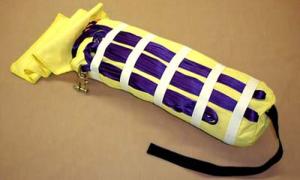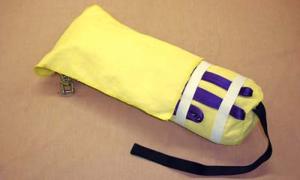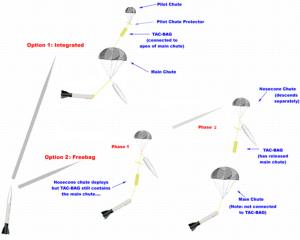TAC Bag (4 sizes)
Deployment Bag from the makers of the TAC Parachutes!
The TAC-Bag has a 1" tubular nylon shock cord running through it so that the TAC-Bag itself does not carry any load. The TAC-Bag also has keepers to neatly hold the shroud line.
NOTE: The keepers are elastic, not solid nylon which can hang up shroud lines.
The TAC-Bag is made of Kevlar™ which is more heat resistant than Nomex™. It offers amazing protection. All sewn with Kevlar™ thread.
...Only the best from TAC!!
Hands down, the most advanced Deployment Bag on the market.
How the TAC-Bag works:
The TAC-Bag is a deployment bag that manages a controlled chute deployment. It is sized for TAC chutes. Using other chutes is not recommended since sizes vary. Fold the TAC-chute and place in TAC-Bag as per the folding instructions on TAC-chute.
There are two deployment options:
Integrated and Free Bag. Refer to the diagram above to determine the attachment method. When attaching chute, be sure to use hardware suitable for the weight of the rocket and the anticipated force of deployment. Never use open eyebolts at an attachment point when using TAC-9 chutes. And be sure to ground test your system to be sure that the chute deploys out of the TAC-Bag.
With the Integrated method, be sure to attach the nylon on the open end of the TAC-Bag to the apex of the TAC-chute. Attach the other end to the cord connecting to the pilot chute. Remember, a pilot chute must be large enough to pull the TAC-chute out of the TAC-Bag.
The Free Bag method allows the two halves of the rocket to descent separately, each with its own chute. Here the chute for the top half of the rocket acts as the pilot chute to pull the TAC-Bag away from the TAC-chute. Be sure NOT to attach the TAC-Bag to the TAC-chute it encloses.
You must use parachute protector pads for the deployment bag and for all other recovery components such as pilot chutes and so forth.
TECH NOTE: Why use a Deployment Bag?
Most believe that deployment bags are used for all around heat protection. True, but that's only part of the story. The main purpose of a deployment bag is for "controlled deployment".
Note in the picture above how the chute is neatly contained in the bag and how the elastic keepers hold the shroud lines. The chances of a tangle or a fouled chute are drastically reduced with the proper use of a deployment bag.
Basically, it's the next step up in recovery, and many fliers take great pride in mastering this more advanced level of recovery. If you've got a serious investment sitting on the pad, or you've got a certification attempt on the line, or you're just ready to move to a more advanced level in the hobby, try a deployment bag. It's a way to move beyond the standard practice of ejecting a rolled up ball of material and shock cord out the tube at blistering speeds and hoping for the best.
There's a better way, and it's called the TAC-Bag. Why is the TAC-Bag better? For one, it's made of Kevlar™, not Nomex™, so the heat rating is higher. Also, compare the construction of the TAC-Bag with other bags. The TAC-Bag is round - - like an airframe - - not square. What's the sense in making a square bag for a round hole? Also, the keepers are elastic and that is really important because they easily release the shroud lines. Careful, non-elastic keepers can bind the shroud lines.







